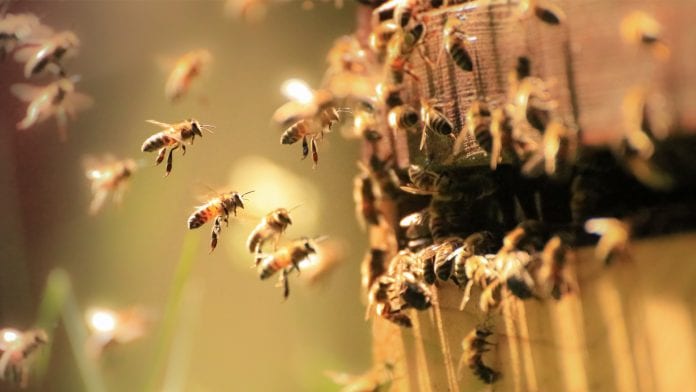
Honey bee colonies around the world are at risk from a variety of threats, ranging from pesticides to habitat loss, but bee parasites are the biggest threat – especially the Varroa destructor.
According to the University of Maryland, USA, research suggests that one threat stands well above the others when it comes to honey bee survival: bee parasites, specifically the Varroa destructor, which specialises in attacking honey bees.
For decades, researchers have assumed that varroa mites feed on blood, like many of their mite and tick cousins. But new research suggests that varroa mites instead have a voracious appetite for a honey bee organ called the fat body, which serves many of the same vital functions carried out by the human liver, while also storing food and contributing to the immune system of bees.
The organ eating mite, Varroa destructor
Published in the Proceedings of the National Academy of Sciences, this study could transform researchers’ understanding of the primary threats to honey bees while paving the way for more effective mite treatments in the future.
Samuel Ramsey, lead author of the study, explains: “Bee researchers often refer to three Ps: parasites, pesticides and poor nutrition. Many studies have shown that varroa is the biggest issue. But when compromised by the varroa destructor, colonies are also more susceptible to the other two.”
“Now that we know that the fat body is varroa’s target, this connection is now much more obvious. Losing fat body tissue impairs a bee’s ability to detoxify pesticides and robs them of vital food stores. The fat body is absolutely essential to honey bee survival.”
In addition to breaking down toxins and storing nutrients, honey bee fat bodies produce antioxidants and help to manage the immune system. The fatty organs also play an important role in the process of metamorphosis, regulating the timing and activity of key hormones. Fat bodies also produce the wax that covers parts of bees’ exoskeletons, keeping water in and diseases out.
Studying the behaviour of bee parasites
Ramsey noted several observations that led him to question whether varroa mites were feeding on something other than haemolymph.
First, insect haemolymph is very low in nutrients. To grow and reproduce at the rates they do, varroa mites would need to consume far more haemolymph than they would be able to acquire from a single bee.
Second, varroa mites’ excrement is very dry, contrary to what one would expect from an entirely liquid blood diet.
Lastly, varroa mites’ mouthparts appear to be adapted for digesting soft tissues with enzymes then consuming the resulting mush. By contrast, blood-feeding mites have very different mouth parts, specifically adapted for piercing membranes and sucking fluid.
Details of the study
The researchers directly imaged the wound sites where varroa mites gnawed on the bees’ abdomens. By doing so, they could see that if the mites grabbed on to random locations, that would suggest that they were in fact feeding on haemolymph, which is distributed evenly throughout the body. On the other hand, if they had a preferred site on the body, that could provide an important clue to their preferred meal.
Moreover, the scientists fed bees with one of two fluorescent dyes: uranine, a water-soluble dye that glows yellow, and Nile red, a fat-soluble dye that glows red. If the mites were consuming haemolymph, a bright yellow glow would appear in the mites’ bellies after feeding. If they were feeding on fat bodies, on the other hand, there would be a red glow.
The results were striking. Mites fed a diet of pure haemolymph starved, while those fed fat body tissue thrived and even produced eggs.
Dennis vanEngelsdorp, a professor of entomology at the university adds: “These results have the potential to revolutionise our understanding of the damage done to bees by mites.”
“Fat bodies serve so many crucial functions for bees. It makes so much more sense now to see how the harm to individual bees plays out in the ways that we already know varroa does damage to honey bee colonies. Importantly, it also opens up so many new opportunities for more effective treatments and targeted approaches to control mites.”









